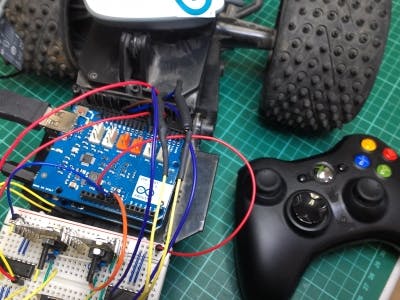First of all you need an old RC car. Luckily I found a monster truck. This can be very interesting!
Remove all the electronics except for the cables to control the two motors.
Take an Arduino board (I chose an Arduino UNO) and plug the USB host shield on it.
Plug the shield on top of the Arduino UNO and the USB Host shield and screw them to the car. I used one of the holes for the old electronic circuit.
I made mine on a breadboard, but you can also build it on a perfboard. Essentially the circuit is composed by two driver (L293D or SN754410) and two voltage stabilizers. The voltage stabilizers are used to limit the voltage from the batteries. In fact I suggest you to use 10-12 AA 1.5V batteries in order to have a maximum voltage of 15-18V that will give you more time to play with the RC car. Since the motor require a high amount of current, in order to move the car from the rest position (about 2A) we need a powerful voltage stabilizer like the 78S12.
If you want more information about how the driver works take a look here !
Find an empty place on the RC car were you can place the circuit. On the monster truck I have, there is a lot of space. Once positioned connect the circuit to the two motors. Finally plug the wireless receiver into the USB host shield.
The code is based on the examples of the USB Host Library 2.0 hosted on GitHub by Kristian Lauszus from circuits@home
/*
Example sketch for the Xbox Wireless Reciver library - developed by Kristian Lauszus
It supports up to four controllers wirelessly
For more information see the blog post: http://blog.tkjelectronics.dk/2012/12/xbox-360-receiver-added-to-the-usb-host-library/ or
send me an e-mail: kristianl@tkjelectronics.com
*/
#include <XBOXRECV.h>
// Satisfy IDE, which only needs to see the include statment in the ino.
#ifdef dobogusinclude
#include <spi4teensy3.h>
#endif
USB Usb;
XBOXRECV Xbox(&Usb);
#define motorPinOne 5 //The chosen pin must have PWM
#define motorPinTwo 6 //The chosen pin must have PWM
#define motor2PinOne 4
#define motor2PinTwo 7
#define BRAKE 2
/* Define the rotational speed of the motor. MUST be between 0 and 255. */
int pulse = 0;
int forward = 0;
int brake_on = 0;
void setup() {
TCCR1B = TCCR1B & 0b11111000 | 0x02;
Serial.begin(115200);
if (Usb.Init() == -1) {
Serial.print(F("\r\nOSC did not start"));
while(1); //halt
motors_stop();
center();
}
Serial.print(F("\r\nXbox Wireless Receiver Library Started"));
pinMode (motorPinOne, OUTPUT);
pinMode (motorPinTwo, OUTPUT);
pinMode (motor2PinOne, OUTPUT);
pinMode (motor2PinTwo, OUTPUT);
pinMode (BRAKE, OUTPUT);
digitalWrite (BRAKE, LOW);
}
void loop() {
Usb.Task();
if(Xbox.XboxReceiverConnected)
{
for(uint8_t i=0;i<4;i++)
{
if(Xbox.getButtonPress(L2, i))
{
Serial.print("L2: ");
Serial.print(Xbox.getButtonPress(L2, i));
pulse = Xbox.getButtonPress(L2, i);
forward = 0;
clockwise();
}
if(Xbox.getButtonPress(R2, i))
{
Serial.print("R2: ");
Serial.println(Xbox.getButtonPress(R2, i));
pulse = Xbox.getButtonPress(R2, i);
forward = 1;
counterClockwise();
}
if(Xbox.getAnalogHat(LeftHatX, i) > 7500 || Xbox.getAnalogHat(LeftHatX, i) < -7500 || Xbox.getAnalogHat(LeftHatY, i) > 7500 || Xbox.getAnalogHat(LeftHatY, i) < -7500 || Xbox.getAnalogHat(RightHatX, i) > 7500 || Xbox.getAnalogHat(RightHatX, i) < -7500 || Xbox.getAnalogHat(RightHatY, i) > 7500 || Xbox.getAnalogHat(RightHatY, i) < -7500)
{
if(Xbox.getAnalogHat(LeftHatX, i) > 7500)
{
Serial.print(F("LeftHatX: "));
Serial.print(Xbox.getAnalogHat(LeftHatX, i));
Serial.print("\t");
if (Xbox.getAnalogHat(LeftHatX, i) > 26000)
turn_right();
else
center();
}
if (Xbox.getAnalogHat(LeftHatX, i) < -7500)
{
Serial.print(F("LeftHatX: "));
Serial.print(Xbox.getAnalogHat(LeftHatX, i));
Serial.print("\t");
if (Xbox.getAnalogHat(LeftHatX, i) < -26000)
turn_left();
else
center();
}
if(Xbox.getAnalogHat(LeftHatY, i) > 7500 || Xbox.getAnalogHat(LeftHatY, i) < -7500)
{
Serial.print(F("LeftHatY: "));
Serial.print(Xbox.getAnalogHat(LeftHatY, i));
Serial.print("\t");
}
if(Xbox.getAnalogHat(RightHatX, i) > 7500)
{
Serial.print(F("RightHatX: "));
Serial.print(Xbox.getAnalogHat(RightHatX, i));
Serial.print("\t");
}
if (Xbox.getAnalogHat(RightHatX, i) < -7500)
{
Serial.print(F("RightHatX: "));
Serial.print(Xbox.getAnalogHat(RightHatX, i));
Serial.print("\t");
}
if(Xbox.getAnalogHat(RightHatY, i) > 7500 || Xbox.getAnalogHat(RightHatY, i) < -7500) {
Serial.print(F("RightHatY: "));
Serial.print(Xbox.getAnalogHat(RightHatY, i));
}
Serial.println();
}
if(Xbox.getButtonClick(UP, i))
{
Serial.println(F("Up"));
}
if(Xbox.getButtonClick(DOWN, i))
{
Serial.println(F("Down"));
}
if(Xbox.getButtonClick(LEFT, i))
{
Serial.println(F("Left"));
}
if(Xbox.getButtonClick(RIGHT, i))
{
Serial.println(F("Right"));
}
if(Xbox.getButtonClick(START, i))
{
Serial.println(F("Start"));
}
if(Xbox.getButtonClick(BACK, i))
{
Serial.println(F("Back"));
}
if(Xbox.getButtonClick(L3, i))
Serial.println(F("L3"));
if(Xbox.getButtonClick(R3, i))
Serial.println(F("R3"));
if(Xbox.getButtonClick(L1, i))
Serial.println(F("L1"));
if(Xbox.getButtonClick(R1, i))
Serial.println(F("R1"));
if(Xbox.getButtonClick(XBOX, i))
{
Xbox.setLedMode(ROTATING, i);
Serial.println(F("Xbox"));
}
if(Xbox.getButtonClick(A, i))
{
Serial.println(F("A"));
}
if(Xbox.getButtonClick(B, i))
{
Serial.println(F("B"));
digitalWrite(BRAKE, HIGH);
brake_on = 1;
pulse = 100;
if (forward)
clockwise();
else
counterClockwise();
}
if(Xbox.getButtonClick(X, i))
Serial.println(F("X"));
if(Xbox.getButtonClick(Y, i))
{
Serial.println(F("Y"));
motors_stop();
}
}
}
delay(1);
}
void clockwise()
{
Serial.print("Rotation is clockwise and speed is ");
Serial.println(pulse);
analogWrite(motorPinOne,pulse); // set leg 1 of the H-bridge low
analogWrite(motorPinTwo,0);
if (brake_on)
{
delay(600);
digitalWrite(BRAKE, LOW);
brake_on = 0;
pulse = 0;
}
}
void counterClockwise()
{
Serial.print("Rotation is counter-clockwise and speed is ");
Serial.println(pulse);
analogWrite(motorPinOne,0); // set leg 1 of the H-bridge low
analogWrite(motorPinTwo,pulse);
if (brake_on)
{
delay(600);
digitalWrite(BRAKE, LOW);
brake_on = 0;
pulse = 0;
}
}
void turn_left()
{
digitalWrite(motor2PinOne,HIGH); // set leg 1 of the H-bridge low
digitalWrite(motor2PinTwo,LOW);
}
void turn_right()
{
digitalWrite(motor2PinOne,LOW); // set leg 1 of the H-bridge low
digitalWrite(motor2PinTwo,HIGH);
}
void motors_stop()
{
analogWrite(motorPinOne,0);
analogWrite(motorPinTwo,0);
pulse = 0;
}
void center()
{
digitalWrite(motor2PinOne, LOW);
digitalWrite(motor2PinTwo, LOW);
}



_ztBMuBhMHo.jpg?auto=compress%2Cformat&w=48&h=48&fit=fill&bg=ffffff)

Comments